To achieve carbon neutrality, Chinese scientists in action


BEIJING -- China's emission control efforts will test and develop a series of scientific conclusions, methods and technological innovations. Many Chinese researchers are now engaged in the carbon emission-related studies.
On Dec 3, Lanzhou University, based in Northwest China's Gansu province, jointly established an institute with LONGi Green Energy Technology Co., Ltd. to build a research and development platform of clean energy technology, equipment and material.
Gansu, with broad Gobi and desert areas, has abundant wind, light and heat resources which can be efficiently utilized to better serve the country's carbon reduction goal.
Previously, the researchers from Lanzhou University have made creative research in thin-film solar cells, silicon solar cells, lithium-ion batteries, water supercapacitors and photocatalytic hydrogen production.
Both silicon and perovskite film material can be used in photovoltaic technology. The College of Chemistry and Chemical Engineering under the university assembled efficient and stable perovskite cells.
China has pledged to have carbon dioxide emissions peak before 2030 and achieve carbon neutrality before 2060, making the world's biggest cut in carbon emission intensity in the shortest time frame in history.
The Chinese Academy of Sciences released the China Sustainable Development Report 2020: Exploring Pathways towards Carbon Neutrality on Oct 25, focusing on a comprehensive green and low-carbon transformation and carbon neutrality roadmap, with goals in phases declared for the country's carbon neutrality commitment.
"As researchers we are fully committed to giving new impetus to sustainability and carbon management," said Zhao Lin, professor of Geocryology with the Nanjing University of Information Science and Technology in east China's Jiangsu Province.
A research team led by Zhao recently discovered that under climate warming, the degradation of permafrost which reserves large amounts of organic carbon might increase greenhouse gas release over permafrost regions of the Qinghai-Tibet Plateau.
His team has made suggestions on restricting human activities in the above-mentioned regions to better protect the permafrost and its carbon sequestration capability.
In July 2021, the researchers with the Institute of Atmospheric Physics (IAP) of the CAS achieved the first global carbon flux data set and map from the country's carbon dioxide monitoring satellite TanSat, indicating that China has the capacity of spatial quantitative monitoring of global carbon budget.
The TanSat was launched on Dec. 22, 2016, making China the third country after Japan and the United States to monitor greenhouse gases with its own satellite.
The satellite's mission is to achieve high-precision monitoring of the global atmospheric carbon dioxide concentration and provide satellite data for scientific research.
It is very important to establish and improve a simulation and inversion system to transform the original satellite observation information into data available for scientists.
Over the years, the researchers from the IAP have developed a remote sensing inversion algorithm to accurately simulate the transmission process of solar radiation in the atmosphere, which greatly increased the accuracy of the global carbon dioxide distribution map generated from the satellite observation data.
Since 2017, the data products of TanSat have been opened for global users for free.
"We hoped to cooperate with overseas counterparts to provide richer monitoring data to cope with climate change," said Liu Yi, a researcher with the IAP.
The design and development of the new-generation carbon satellite have been put on the agenda to meet the country's carbon reduction commitment, said Liu.
Peaking carbon dioxide emissions and achieving carbon neutrality will bring about a sci-tech revolution, resulting in major changes in the economy and society, which is no less important than the three previous industrial revolutions, said Chinese Minister of Science and Technology Wang Zhigang at the Xiangshan Science Conferences held in Beijing earlier this year.
During an annual ceremony held on Nov 3 in Beijing to honor distinguished scientists, engineers and research achievements, a batch of key technologies for peaking carbon emissions and achieving carbon neutrality, pollution control and clean-energy application were awarded, such as the biological denitrification of sewage and the advanced treatment of industrial flue gas.
The minister called on Chinese researchers to create competitive advantages through sci-tech innovations to support China's low-carbon development.
Science is key to ensuring the simultaneous realization of carbon neutrality and economic and social development, he said.
- Remains of former senior military official cremated
- China strives to build South China Sea into a sea of peace, friendship, cooperation
- Xi, Myanmar leader exchange congratulations on 75th anniversary of diplomatic ties
- Why Guangdong-Hong Kong-Macao Greater Bay Area is a must-watch for global businesses
- Hefei mobilizes public to build spiritual civilization
- Experts urge stronger civil aviation legislation, cultivation of legal talents





































